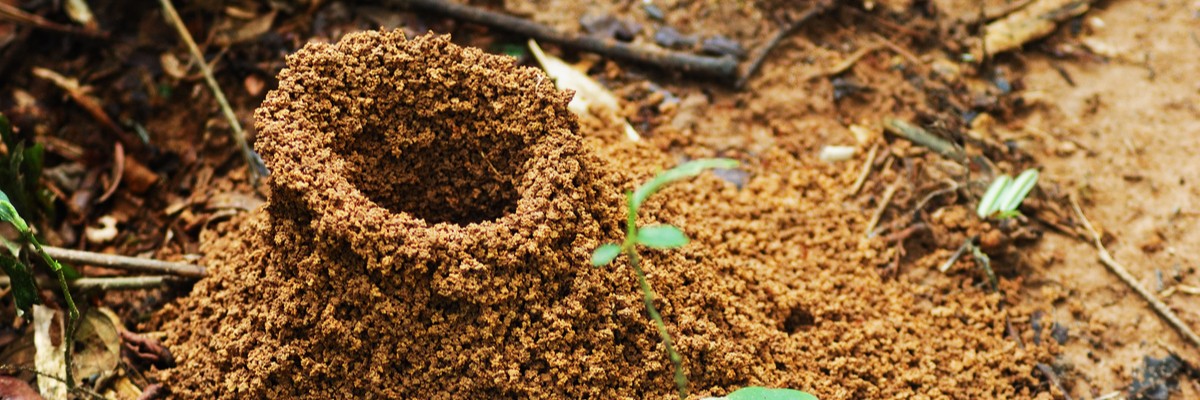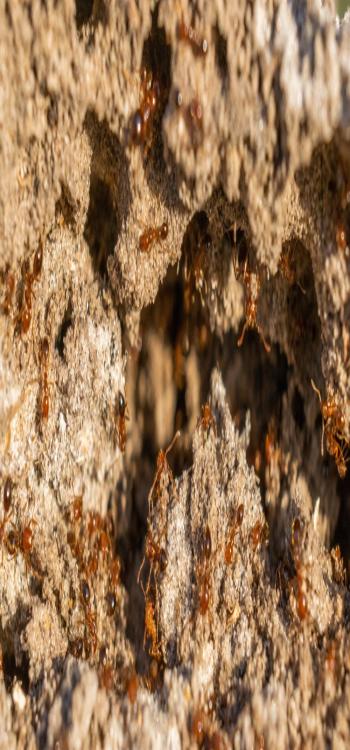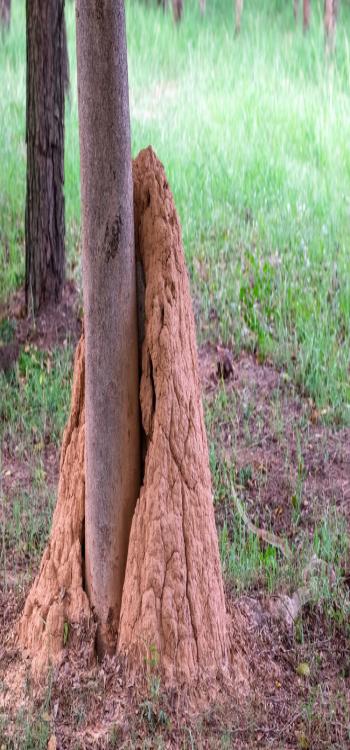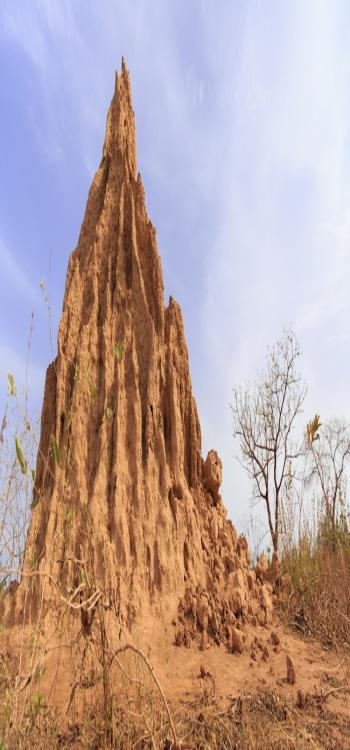Humans aren’t the only living creatures on earth that have awe-inspiring homes, there are many animals, birds and insects that put massive amounts of effort into building great homes. Many we might see but not pay attention to, and many we don’t even know about. But the home of ants is one that we can easily spot, maybe in our own backyard.

Things we covered for you
In this article, we will answer a few common questions about ant hills and what makes them so unique.
Do all Ants Live in Anthills?
No, not all ants live in your conventional ant hill, they live in colonies in the ground, a crevasse in your walls, in trees, and there is even a species known as army ants that fight during the day and build a temporary nest for the night and move on the next day. When the queen of this species lays eggs, the worker ants make a nest out of their own bodies to protect the queen!
Which Species of Ants Build Anthills?
If you’re wondering who builds ant hills, the answer is not all ants build them. Anthills are built by a few species of ants such as popular anthill builders Formica ants. The other popular species include Yellow Meadow Ants, Fire Ants and Harvester Ants to name a few. Another type of anthill house which looks like a simple mound above ground is built by ant species like pyramid ants, Argentine ants, Allegheny mound ants, and Texas leafcutter ants to name a few.
Who Lives in Anthills?
This might seem like a pretty obvious question, yes ants do live in anthills. But, I could name some other creatures that live in anthills, such as beetles, a few species of lesser breeds of ants, and a greenfly, a small insect.
What Does an Anthill Look like?
The exterior of an anthill is not impressive at all. It usually looks like a pile of sand, a small mound that has a crater in the middle, like a bullseye. In the wild, you might find massive ant hills that look like large piles of mud that are several meters high, it can range from an inch to over 10 feet! The red imported fire ant makes cone-shaped ant hills that are more pointed and pronounced as compared to the regular ant hills. The top of anthills is actually the tip of the iceberg, it is what is underneath that is the real marvel.
The inside of the anthill is a very complex structure and has many tunnels that connect many chambers of varying sizes. Each chamber has a different purpose. These rooms can be used as nurseries, for storing food, and even a place to rest for worker ants. It’s interesting to note that the worker ants move the larvae up to the rooms nearer the top of the anthill to keep it warm during the day. At night they move them to lower chambers to keep them safe.
What is Ant Hills Made of?
How ants build their homes is very interesting to watch. Most ant hills are made from fine sand, dirt, clay and twigs. You won’t find gravel or stones in the anthills as these are too heavy for ants to carry. They use twigs to help fortify their structure and also give them better protection against the weather. As an anthill is their house, ants may even use seeds that will sprout and grow from the hills, this work as a great camouflage for the hill. Ants make anthills with a long lifespan, this way they don’t have to rebuild them often and it is a safe and sturdy structure for them.
How and Why do Ants Make Anthills?
Ants make hills to keep their queen and their larvae safe. These hills are actually made by worker ants who dig subterranean tunnels. When the ants dig the tunnels, they carry away the earth they don’t need on their back and drop it off near the entrance. This is how the heaps or mounds are formed outside the entrance of the anthill.

Where do Ants Build Anthills?
Ants choose to build their homes in strategic locations, they choose places where they will have shelter and protection from their predators. They choose places like between tree roots, under stones, inside tree logs etc. They choose solid structures so that they get the most protection possible.
Read: Here’s How to Get Rid of Ants Permanently in Your House
The best ant hills are the ones that last the longest. The common features found in these ant hills are that they picked a great location for their home, and the environment was ideal for them i.e. had a lot of food. You will even find that ants build their hills in such a way that it will face the direction where there is the most sunshine.

Read: Professional Floor Mounted AC Services In Delhi By NoBroker
How Long Does it take Ants to Build an Anthill?
The time it takes to build ant hills depends on the species of the ant. For example, the Allegheny Mound Ants, take 1 year to build 1 foot.
It has also been found that ants have cooperating colonies, here ant colonies are combined to make humongous colonies. The largest is one that stretches over 13 miles (670 acres) in Hokkaidō Japan. There is also one that covers 6,000 kilometres in Europe. These are Argentine ants; they live in harmony and there are actually billions of them living in cooperating nests.

How long do Ant Hills Survive
If built well, and with the right materials, the anthill structure can easily last hundreds of years. Most usually these anthills survive anywhere from 1 to 30 years.
Why Would Ants Abandon their Homes?
The most common reason ants leave their nests is because of invaders or damage. When there is flooding, and the colony is not made to withstand it they will leave the nest. There are also a lot of creatures that enter the nest to feed on the larvae and the ants, the most dangerous being insects like the beetle, which burrow into the ant’s nest and eat the eggs and larvae.
There are also humans that either accidentally or purposefully destroy these anthills. Once destroyed the ants evacuate and build a new nest as soon as possible. Species like the fire ant only take days to build a new anthill and they do it with ease.
Read: A Complete Guide on How to Keep Your Kitchen Bug-Free
What do you do if you Spot an Anthill near your Home?
The problem with ants near your home is that they will start invading your home to find food. If you spot an anthill, you need to take quick action before they become a menace. To get rid of them you can do simple things like just flattening the nest (this will alert the ants to move as this location is no longer safe). You can pour boiling water into the mound; this is harsh but effective. You can sprinkle the boric acid powder on the mound, you can even pour soda or any carbonated beverage into the mound, this causes ants to suffocate at the deeper levels.
The inside of an anthill
The anthill is divided into two sections: one above ground and one below. Both halves include an extensive network of tunnels that connect numerous chambers of various sizes. The ants frequently arrange the pupae towards the top of the anthill to take advantage of the sun. The ant colony is designed to be as efficient as possible, meeting as many needs as feasible. Formica ant queens begin laying eggs again as the Nordic winter draws to a close. Even if the ant mound is covered with snow, the temperature inside can still be approximately 26-28°C (78-82°F).
The diverse sections of the anthills are employed to provide the best climate for the brood and queens as the seasons change. They are carried to the top of the anthill when it is warm. They are carried down to the warm and damp basement chambers when there is a drought or it is simply too cold outside.
An ant house is called an anthill. Its surface may appear to be a boring crust of pine needles, but it is actually covered in little entrances. The ants utilise them as doors, opening and closing them. Instead of hinged doors, they use stones and other natural materials to keep the weather and attackers out.
How big can ant hills get
Of course, there are various types of ant hills – both small and large ant mounds, as well as everything in between. The Formicas are the ones who make the biggest anthills. Their mounds (Formica aquilonia) can grow to be as tall as 2.5 metres (8.2 ft). One wood ant’s nest (Formica polyctena) can measure up to 20 metres in circumference (65 ft).
Where do ants build anthills?
Ants like to take advantage of their surroundings. This is why many ant hills (ant house name) are intentionally placed near trees, on top of (or under) stones, logs, or stubs. The ants are protected by their sturdy fortress from both threats and natural forces. As a result, the ant colony becomes more successful than its competitors. The ant hills that last the longest are probably those that have both a wonderful nest place and a good habitat (rich in material and food). Anthills in the northern hemisphere are frequently built towards the south, as this is where the sun shines the brightest.
Vastu for ant house
Although there are a lot of superstitions and myths surrounding Ants, Vastu Shastra does not recommend or advocate living near ants or anthills. Although the general notion surrounding anthills is that plots of land with anthills or in the proximity of ant hills should be avoided. The reason being anthills are often chosen for inhibition by snakes.
The best way to get rid of ants that are plaguing your home is to call in professionals. They have the right tools and materials to get the job done right so that the ants don’t come back anytime soon.
If you’re looking for pest control services, just visit NoBroker, we have a team of professionals who can help you with any type of pest or insect. You can even get excitingDISCOUNTS, try it now.
FAQ’s
Ans. Ants have a brief life cycle in general, although certain colony members can live anywhere from a few days to a few decades. Another key aspect that influences ant longevity is species. Workers of odorous house ants, a typical ant found inside dwellings, live for two to three years on average, while fire ant workers survive for only five weeks.
Ans. Ant shelters are named anthills.
Ans. A vinegar mix of water/soda sprayed on the affected areas will help get rid of ants faster.
Ans. The Formicas are the ones who make the biggest anthills. Their mounds (Formica aquilonia) can grow to be as tall as 2.5 metres (8.2 ft). One wood ant’s nest (Formica polyctena) can measure up to 20 metres in circumference (65 ft).
Ans. Although nearly all of them can bite or sting humans, only a few can induce a major local and/or systemic reaction. The majority of ants are too little to bite humans, and their sting is moderate. Harvester and fire ant stings, on the other hand, can induce unpleasant symptoms and allergic reactions.










